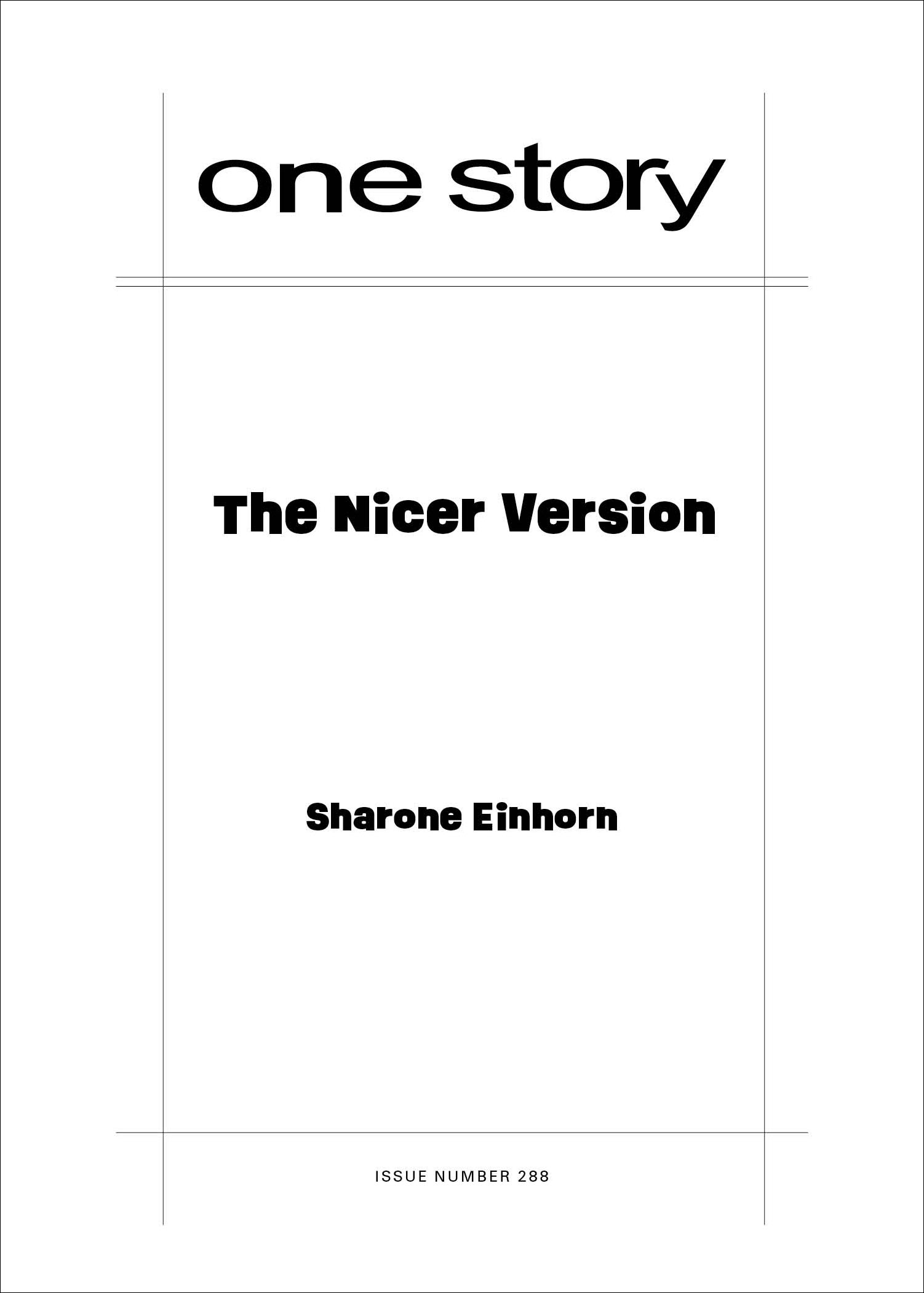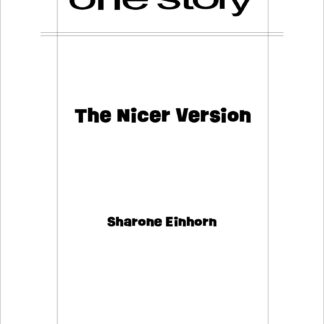
The Nicer Version
$2.50
275 in stock
Excerpt
Just before the pandemic lockdown, the day before everything shut, I adopted Libby at the animal shelter in Bay Shore. They had some flim-flam story about the dog being dropped off at a church in South Carolina during a snowstorm on Christmas Eve. A beautiful young veterinary technician handed Libby’s nylon leash to me in the parking lot—the lobby was already locked because of Covid—to take her for a spin and told me the unlikely romantic tale.
Abandonment, a church, snow, Christmas. Now that I wasn’t young, every young woman looked heartbreakingly beautiful to me. I could always find something, lively hair, the way it moved, plump skin, like creamy elastic velvet. An as yet uncrushed soul. This new me—old me—blindly sentimental, believed that youth was beauty, even if, objectively, that wasn’t always the case.
Sharone Einhorn
Sharone Einhorn has been an antique dealer and a secret writer on Eastern Long Island for many years. Her poetry has appeared in The American Poetry Review several times as well as The Quarterly and other publications. This is her first published story and comes not a minute too soon.
Will Allison on “The Nicer Version”
This month—our 20th anniversary—we’re thrilled to bring you our first debut story of the year, Sharone Einhorn’s “The Nicer Version,” which spans the early months of the Covid-19 pandemic. But while “The Nicer Version” could certainly be called a pandemic story, it’s also an unforgettable dog story, and even a love story of sorts.
According to the ASPCA, nearly one in five American households adopted a pet during the pandemic, Einhorn’s narrator among them. A divorcée of a certain age living in the suburbs of eastern Long Island, she visits local shelters in search of a “lively dog” that will be good with her two cats.
What she ends up with is a seventy-two-pound panting behemoth of questionable lineage named Lady (née Libby), whose habits include jumping out of moving cars, discharging clouds of bristly white hair, trying to attack other dogs, and blithely murdering voles, squirrels, and rabbits. Worst of all, Lady has a fickle heart. When a friend from New York City comes to stay with the narrator, Lady jilts her owner and falls slavishly in love with the friend.
As the pandemic drags on, the narrator negotiates her relationship with Lady against a backdrop of getting older, the inexorable drumbeat of aging. And ultimately, that’s what “The Nicer Version” is mostly about—not just the pandemic and a dog and love but also the “jagged precipice of hagdom,” as the narrator puts it. Her take on aging is by turns bleak, resigned, and angry, but also very funny, rendered in plainspoken prose full of quietly poetic descriptions. It’s a voice I found irresistible from the opening sentence all the way through to the unexpected (and unexpectedly hopeful) ending. Please join me in welcoming Ms. Einhorn’s first published story to the pages of One Story, with hopes of many more to come.
Q&A by Will Allison
- WA: Where did the idea for this story come from?
- SE: I have a dog-trainer friend who told me hair-raising stories about first-time dog owners adopting dogs during the pandemic. I was interested in the repercussions of adopting a difficult dog, or a difficult person adopting a difficult dog, in a difficult time.
- WA: What was the most challenging aspect of writing this story?
- SE: The challenge for me was to allow the narrator to go where the story took her, to let her rant the truth of her feelings, her frustration, and ultimately to get to that place of acceptance.
- WA: With apologies to Lassie, et al., Lady (née Libby) is perhaps the most memorable fictional dog I’ve encountered. Was developing a dog character any different from developing a human character?
- SE: No, in fact, a dog was easier to bring to life, partly because dogs can’t talk. But the dog’s character was informed by the narrator’s character too. Dogs are pretty transparent, dogs don’t lie, and dogs take on their owner’s traits. One of my favorite books is J. R. Ackerley’s My Dog Tulip.
- WA: The narrator of “The Nicer Version” is getting up there in years, and I love her musings on growing older, which are by turns wistful, bitter, philosophical, and quite funny. Did you set out to write about aging, or did the theme emerge in the course of drafting the story?
- SE: The story began simply as a portrait of the rescue dog and her owner. The theme of aging just poured out.
- WA: This is your first published story, but you’ve published poetry in The American Poetry Review, The Quarterly, and elsewhere. When and why did you start writing fiction?
- SE: I started writing fiction years ago, specifically short stories, because I love reading them. I love being able to sit down and read a story from beginning to end in a short amount of time. Poetry is so condensed; I wanted to spread out and try to tell a good story.
- WA: Following up on that, I know from our conversations that most of your stories are rooted in personal experience. Why did you choose to render them in fiction instead of nonfiction?
- SE: We all have stories. I do start from personal experience, but then I embellish, exaggerate, add, subtract, lie, and change endings.
- WA: Who are some of your favorite authors, and what are you reading now?
- SE: Always, Flannery O’Connor. Recently, Olga Tokarczuk, Richard Yates, Lucia Berlin, Sigrid Nunez, Thomas Bernhard. I just finished Caroline Blackwood’s Great Granny Webster, which is fantastic.
- WA: How long did it take you to complete this story?
- SE: About a month to write, a couple of months to revise and edit.
- WA: What are you working on now?
- SE: I’m writing something long now, a novel. I’m about halfway through. I try to write a story when the going gets tough, when I need a break.
- WA: What is the best bit of advice about writing you have ever received?
- SE: Someone in a workshop last century said to write from a place of jeopardy, be worried about people reading what you write, especially people close to you, then you will know that you are telling the truth.
